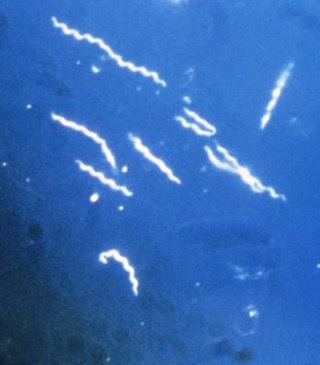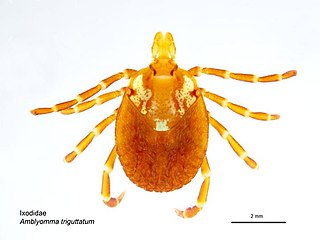
Rocky Mountain spotted fever (RMSF) is a bacterial disease spread by ticks. It typically begins with a fever and headache, which is followed a few days later with the development of a rash. The rash is generally made up of small spots of bleeding and starts on the wrists and ankles. Other symptoms may include muscle pains and vomiting. Long-term complications following recovery may include hearing loss or loss of part of an arm or leg.

Ticks are parasitic arachnids of the order Ixodida. They are part of the mite superorder Parasitiformes. Adult ticks are approximately 3 to 5 mm in length depending on age, sex, species, and "fullness". Ticks are external parasites, living by feeding on the blood of mammals, birds, and sometimes reptiles and amphibians. The timing of the origin of ticks is uncertain, though the oldest known tick fossils are from the Cretaceous period, around 100 million years old. Ticks are widely distributed around the world, especially in warm, humid climates.

The Ixodidae are the family of hard ticks or scale ticks, one of the three families of ticks, consisting of over 700 species. They are known as 'hard ticks' because they have a scutum or hard shield, which the other major family of ticks, the 'soft ticks' (Argasidae), lack. They are ectoparasites of a wide range of host species, and some are vectors of pathogens that can cause human disease.

Borrelia is a genus of bacteria of the spirochete phylum. Several species cause Lyme disease, also called Lyme borreliosis, a zoonotic, vector-borne disease transmitted by ticks. Other species of Borrelia cause relapsing fever, and are transmitted by ticks or lice, depending on the species of bacteria. A few Borrelia species as Candidatus Borrelia mahuryensis harbor intermediate genetic features between Lyme disease and relapsing fever Borrelia. The genus is named after French biologist Amédée Borrel (1867–1936), who first documented the distinction between a species of Borrelia, B. anserina, and the other known type of spirochete at the time, Treponema pallidum. This bacterium must be viewed using dark-field microscopy, which make the cells appear white against a dark background. Borrelia species are grown in Barbour-Stoenner-Kelly medium. Of 52 known species of Borrelia, 20 are members of the Lyme disease group, 29 belong to the relapsing fever group, and two are members of a genetically distinct third group typically found in reptiles. A proposal has been made to split the Lyme disease group based on genetic diversity and move them to their own genus, Borelliella, but this change is not widely accepted. This bacterium uses hard and soft ticks and lice as vectors. Testing for the presence of the bacteria in a human includes two-tiered serological testing, including immunoassays and immunoblotting.

Amblyomma is a genus of hard ticks. Some are disease vectors, for example the Rocky Mountain spotted fever in United States or ehrlichiosis in Brazil.

Amblyomma americanum, also known as the lone star tick, the northeastern water tick, or the turkey tick, is a type of tick indigenous to much of the eastern United States and Mexico, that bites painlessly and commonly goes unnoticed, remaining attached to its host for as long as seven days until it is fully engorged with blood. It is a member of the phylum Arthropoda, class Arachnida. The adult lone star tick is sexually dimorphic, named for a silvery-white, star-shaped spot or "lone star" present near the center of the posterior portion of the adult female shield (scutum); adult males conversely have varied white streaks or spots around the margins of their shields.
Ehrlichia chaffeensis is an obligate intracellular, Gram-negative species of Rickettsiales bacteria. It is a zoonotic pathogen transmitted to humans by the lone star tick. It is the causative agent of human monocytic ehrlichiosis.

Amblyomma cajennense or Cayenne tick is a species of tick found in a range from the southern part of the United States to northern Argentina, through Central America and some of the Caribbean. As a consequence, the species has adapted to a wide range of environmental conditions. There are also major geographic barriers such as large rivers and the Andes mountain range.
Dabie bandavirus, also called SFTS virus, is a tick-borne virus in the genus Bandavirus in the family Phenuiviridae, order Bunyavirales. The clinical condition it caused is known as severe fever with thrombocytopenia syndrome (SFTS). SFTS is an emerging infectious disease that was first described in northeast and central China 2009 and now has also been discovered in Japan, South Korea, Vietnam and Taiwan in 2015. SFTS has a fatality rate of 12% and as high as over 30% in some areas. The major clinical symptoms of SFTS are fever, vomiting, diarrhea, multiple organ failure, thrombocytopenia, leukopenia and elevated liver enzyme levels. Another outbreak occurred in East China in the early half of 2020.

Ticks of domestic animals directly cause poor health and loss of production to their hosts. Ticks also transmit numerous kinds of viruses, bacteria, and protozoa between domestic animals. These microbes cause diseases which can be severely debilitating or fatal to domestic animals, and may also affect humans. Ticks are especially important to domestic animals in tropical and subtropical countries, where the warm climate enables many species to flourish. Also, the large populations of wild animals in warm countries provide a reservoir of ticks and infective microbes that spread to domestic animals. Farmers of livestock animals use many methods to control ticks, and related treatments are used to reduce infestation of companion animals.

Amblyomma triguttatum, commonly known as the ornate kangaroo tick, is a species of tick in the genus Amblyomma native to Australia, in Western Australia, parts of Queensland, and in New South Wales.
Amblyomma patinoi is a species of tick of the genus Amblyomma. The species is associated with the Eastern Cordillera of Colombia. Rickettsia species can habitate A. patinoi endosymbiotically.
Amblyomma interandinum is a species of tick of the genus Amblyomma. The species is associated with the northern part of the Inter-Andean valley of Peru. Rickettsia species can habitate A. interandinum endosymbiotically.
Amblyomma gervaisi is a hard-bodied tick of the genus Amblyomma. The tick is a parasite of snakes, such as Naja naja, Python molurus species and monitor species such as Varanus ocellatus, Varanus yemenensis, Varanus benghalensis, Varanus griseus and many other Varanus species in southeastern Asia and Asia-minor. They exhibit sexual dimorphism. They can be found in Sri Lanka, India, Yemen, Saudi Arabia. It is a potential vector for Coxiella burnetii.
Amblyomma javanense is a hard-bodied tick of the genus Amblyomma. It is found in Vietnam, Indonesia, Malaysia, India, Sri Lanka, Philippines and Thailand. It is the only ectoparasite found on the Manis javanica, Manis crassicaudata and also from Sus scrofa.

Amblyomma testudinarium is a hard-bodied tick of the genus Amblyomma. It is found in Indonesia, India, Japan, Thailand, Sri Lanka and Vietnam. Adults parasitize various larger mammals such as buffalo and cattle, whereas nymphs and larvae use mostly larger and medium mammals.

Archaeocroton sphenodonti, or the tuatara tick, is a species of tick that parasitises only the tuatara of New Zealand. It is found on just four of the twelve island groups where tuatara survive, preferring islands where the reptiles live in high densities. Larvae, nymphs, and adults all feed exclusively on tuatara blood, and ticks can survive for up to a year without a host. When tuatara are translocated, the tick has been lost or survives only in low densities in the new population. It is the only living species in the genus Archaeocroton.
Maria Tonelli-Rondelli was an Italian entomologist who studied the taxonomy and identification of ticks (Ixodidae), especially South American species.

Amblyomma triste is a tick in the Amblyomma genus. The tick can be found in Venezuela, Argentina, Brasil, Colombia, Peru and Uruguay. Though not thought to be endemic to North America, a 2010 study found 27 specimens in 18 separate collections that had previously been misidentified in the United States.










